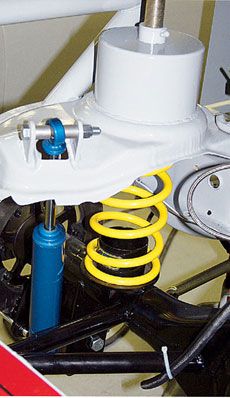
We have been asked to present more basic information on subjects such as shocks. Sometimes, no matter what your level of understanding of a particular technology, it can be a good thing to be refreshed on the more basic information. So, we present a multi-part series on the racing shock.
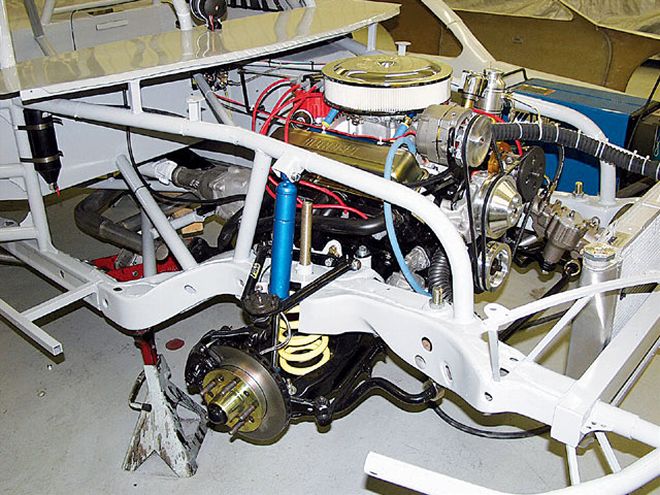 Shocks come in an assortment of designs for different types of racecars and applications. The right shock brand and design for your type of racing depends on both your budget and your ability to understand how to effectively use your shocks to improve entry and exit performance.
Shocks come in an assortment of designs for different types of racecars and applications. The right shock brand and design for your type of racing depends on both your budget and your ability to understand how to effectively use your shocks to improve entry and exit performance.
I have heard claims by shock "experts" that all you have to do is bolt on their shocks and you will instantly be "bad fast," or three tenths quicker. While we do agree that gains in performance are possible and loss in performance often comes with running the wrong rates of shocks, the first order of business is to work out any basic chassis setup problems you might have before experimenting with shocks. Most shock experts will agree on that principle. Let's look at what shocks can do and cannot do.
What Shocks Will Not Do1. Shocks do not support the car.2. Shocks do not control the amount of load transfer.3. Shocks do not affect chassis balance at steady state mid-turn.4. Shocks are not a cure-all for basic handling problems.
What Shocks Will Do1.Shocks control (limit the speed of) motion of the chassis and the suspension.2.Shocks, with varying designs of resistance, allow more or less rapid movement of a suspension corner than opposing corners.3.Shocks regulate the amount of time it takes for a corner of the car, while in transition, to assume a new ride height. 4.Shocks can be used to redistribute the amount of load on the four corners of the car as it is in transition on corner entry and exit.5. And, shocks can be used to "tie" down one or more corners of the car, be that a good thing or a bad thing.
How Shocks Work Shocks resist motion by using a piston that must move through a fluid (thin oil) as the suspension moves, so that the fluid must pass through holes, valves and slots. Varying resistance is created when the oil is forced through different sized openings. The resistance is usually different for compression (inward motion) and rebound (outward motion).
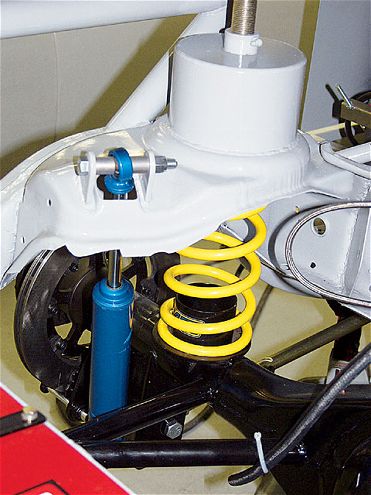 This shock is mounted inline, front to rear, with the rear spring. This means that the shock moves at the same speed as the spring. It is also mounted straight up so there is no motion ratio due to angularity either.
This shock is mounted inline, front to rear, with the rear spring. This means that the shock moves at the same speed as the spring. It is also mounted straight up so there is no motion ratio due to angularity either.
All racing shocks are of two basic designs-twin-tube and mono-tube and can be either gas pressurized or "low" pressure. The twin-tube has literally two tubes, the inside tube is where the work is done and the outside tube is a reservoir that holds extra fluids and a flexible gas-filled bag.
Shocks are Spring Dampeners Shocks are installed in racecars, as in any car, to primarily control oscillations caused by the displacement of the springs, especially coil springs. If we place a load on an undampened spring, such as when they support the car, and then push and release on one corner of the car, the spring will compress and decompress in a series of diminishing oscillations over a relatively long period of time. There is no known advantage to this condition and many disadvantages, so we use dampers to control and slow down the movement of the springs.
In our racecar, both the shocks and the springs resist compression or bump at any one corner of the car. When that same corner tries to return to its normal ride height, the spring promotes that motion and the shock resists. The control of these two motions, compression (bump) and rebound (droop) is the primary function of the shocks.
Compression and Rebound The compression control side of what the shock does resists:1.The bump movement of a corner of the car when we hit bumps (rises in the track).2 The movement due to the transfer of load to the front end during braking/deceleration.3.The movement due to the transfer of load to the rear upon acceleration.4. And the speed at which the right-side springs compress when the lateral forces are applied as we deviate from a straight line and turn left.
The rebound control side of the shock dynamics resists the following:1.Rear chassis rebound vertical movement on deceleration.2.Front chassis rebound movement on acceleration.3.And left side rebound (in some cases, but not all) vertical movement caused by load transfer as we negotiate the turns.
The amount of resistance that the shock provides with each movement, compression and rebound, does increase with the speed at which the shock is forced to move. Low speeds create low resistance and high speed movement creates higher resistance. So, we have two areas related to resistance, low speed and high speed.
Low Speed Control Low-speed shock movement is defined as shaft speeds that are between one to five inches of movement per second. Many racers use three (3) inches per second to evaluate the shock's resistance. These lower speeds are mostly associated with suspension movement caused by chassis roll and chassis dive at turn entry where the loss of speed is moderate. The low speed control dictates much of the handling side of the shock design and racetrack performance gains related solely to chassis balance and load redistribution.
Each shock has a piston mounted on the end of the shaft and one or more small holes in the piston allow fluid inside of the shock to flow freely from one side of the piston to the other. The size of the "bleed" holes regulate how quickly the fluid will flow back and forth and that is how the different levels of resistance are created for low speed control. All low speed adjustments on shocks that are built with that adjustment capability work by changing the size of the bleed opening to control the amount of flow. This adjustment can be for both rebound and compression or just one.
High speed control As we experience the greater velocities of shaft movement, we go into what is called high speed control with shaft velocities of from 5 to 10-plus inches of movement per second. Types of suspension movement that cause the higher shaft speeds in our shocks are:1.Bumps or holes in the racing surface (creating very high shaft speeds).2.The driver stabbing the brakes on entry and hard on the throttle on exit.3.Or a sudden change in banking angle, such as transitioning from banking onto the apron of the racetrack.
The piston mounted to the end of the shaft also contains a valving mechanism which allows the fluid to flow through slots that are designed into the piston. These valves consist of disks that open as the pressure increases due to more rapid shaft movement in either compression or rebound. These disks are used to control the dampening rate associated with higher shaft speeds.
Shaft Displacement An important consideration in designing a racing shock is called shaft displacement. When the shock shaft is pushed into the shock body and into the fluid, it takes up space. Suppose we pull the shock shaft out as far as it would go, fill the shock body with oil and then reseal the shock body. If we tried to push the shaft into the shock body and into the volume of oil, it would not go because the shaft would be trying to compress and displace some of the oil. Oil will not compress, and in a sealed environment, none of the oil can escape.
We need to create a space inside the shock and fill it with a substance that will compress. Gases such as air and nitrogen will compress. Every shock needs to have a certain volume of gas along with the fluid, in order to allow for the displacement of the fluid as the shaft moves into the shock body and takes up space.
The gas should not be air or any gas that would contain moisture (water) due to the heat generated by shock/fluid movement. The moisture would heat up and expand, causing high pressure buildup inside the shock. Nitrogen is a dry gas that suits our purpose and is widely used as a gas filler in racing shocks.
Keeping the Oil and Gas Separate The nitrogen gas we put into our shocks to compress and allow for the volume of the shock shaft must be separated from the fluids in all shocks. The gas can be contained inside a plastic bag or separated by another piston. Because the bags used in twin-tube designs are not pressurized, these shocks are referred to as non-pressurized shocks. In truth, as the shock shaft is pushed into the shock body, some amount of pressurization must take place due to the displacement of the shaft and smaller volume of gas created inside the body. The gas bag must contract, which creates a small amount of pressure.
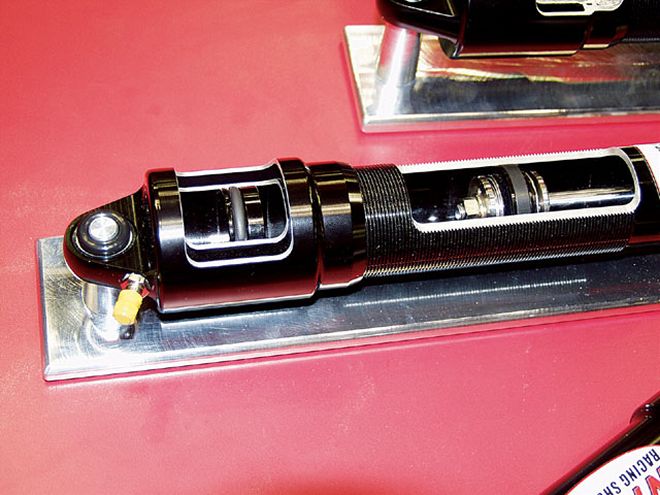 This cut-away of an Integra shock shows the working piston, valves and seal and also the upper floating piston that separates the oil from the pressurized gas.
This cut-away of an Integra shock shows the working piston, valves and seal and also the upper floating piston that separates the oil from the pressurized gas.
In mono-tube shocks, separation is accomplished by installing a second separator piston, which provides a seal that separates the fluid from the gases. A valve that is installed in the shock body at the gas chamber end of the shock allows us to pressurize the gas inside the shock. This pressure ensures that the gas will be forced to be separated from the fluids at all times. That is because the seal on the piston will usually allow air to seep past the piston from the fluid side to the gas chamber, but seals the heavier fluid from escaping into the gas chamber.
The Effect of Installation Ratios If the speed at which the shock moves determines the number of pounds of resistance, then how and where we install the shock is a consideration. If the shock were to be mounted at the center of the front wheel, or on top of the ball joint, then the vertical wheel speed would equal the shock shaft speed. This is never the case in a stock car because of installation issues.
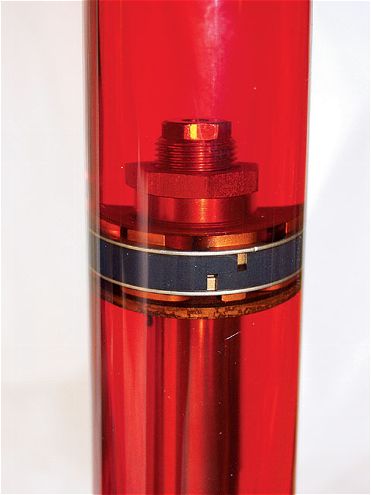
In the front suspension, there is always an installation ratio and shock angle that affects the relationship between the vertical wheel movement and the shock shaft velocity. The farther the shock is mounted from the ball joint and the greater the shock angle from 90 degrees off the control arm that it is mounted to, the slower the shaft will move in relation to the wheel movement.
If shaft speed determines the shock resistance, then the slower the shock moves, the less rate of resistance it will have. Therefore, if I mount the same shock two inches from the ball joint verses mounting it six inches from the ball joint, I will have much more shaft speed and more pounds of resistance with the first mount. It makes sense that I would need a much stiffer shock when mounting it at six inches than I would need if mounting it at two inches. Many racers miss this important point.
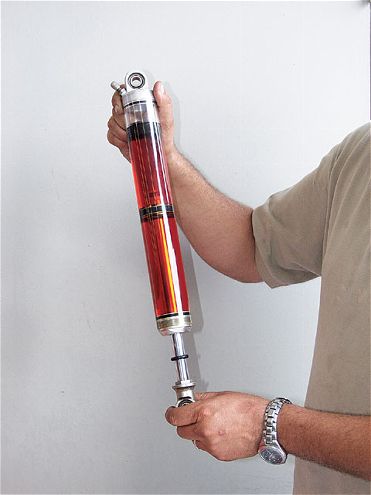 A mono-tube, gas pressure shock has a separator piston that provides a seal between the pressurized nitrogen gas and the shock fluid. As the shock shaft is pushed into the shock body and fluid, it displaces some of the fluid under the separator piston. The gas will compress as the separator piston moves up to make room for the area of the shaft.
A mono-tube, gas pressure shock has a separator piston that provides a seal between the pressurized nitrogen gas and the shock fluid. As the shock shaft is pushed into the shock body and fluid, it displaces some of the fluid under the separator piston. The gas will compress as the separator piston moves up to make room for the area of the shaft.
Linear and Digressive DesignsThere are two basic piston designs used in most circle track racing. One is the Linear piston which has a high flow rate at low shaft speeds and hence little resistance, and increases resistance as the shaft speed increases. The rate of the shock continues to increase as long as the speed increases.
The other design, using a Digressive piston design, has a low flow rate at low shaft speeds which provides a lot of resistance and control, and then the resistance rate increases with increased shaft speeds to a pre-determined level and then tapers off. As the shaft speed continues to increase, the resistance stays uniform above a certain shaft speed. This "pop-off" characteristic works well for reducing the possibility of building excessively high amounts of resistance, usually associated with sharp increases in shaft speeds due to running over bumps and holes in some racetracks.
A New Trend Takes Shape Another development that has recently become popular involves using more rebound resistance than compression control. If we read the older automotive design books related to shock design for production automobiles, we see where the design criteria called for equal resistance in both directions, compression and rebound, in combination with the action of the springs. Because springs naturally resist compression and aid in rebound (unloading of load) we need less compression and more rebound control in our shocks to be truly equal in each direction of movement.
We cannot use a true 50/50 rated shock (where the resistance is the same on both rebound and compression), when installed in combination with a spring. Correct thinking would have us install a shock that has more rebound control than compression resistance. More and more teams are utilizing split-valve shocks which are higher in rebound resistance and the results are faster turn speeds due to a more balanced movement of the front and rear suspension systems.
Maintenance Shock maintenance is a must in racing. The shocks do a lot of work throughout each race and certainly through an entire season. We need to be sure to check our shocks for bent components, sticking mono-balls in the ends, leaking fluids and loss of pressure in the pressurized types of shocks. We should find a shock maintenance facility and have the shocks run through a dyno to make sure they hold their intended rate.
If your shocks are re-buildable, take them apart often to check seals, valve disks, and to replace the oil periodically. Always use nitrogen gas to pressurize your shocks and recheck the pressures often. Make sure the gas bag is intact and holds the gas without leaking. Check for contact between the shock body and the coilover spring or any other part of the chassis. This will have a very negative affect on the setup of the car.
In part two, we will get a little deeper into shock technology and design. We will look at modern day shock graphs, and see how we might improve our performance by using different rate shocks in relation to various types of setups, racetrack designs and track conditions.